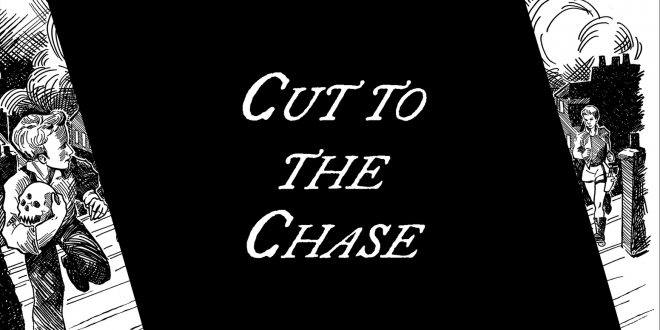In this episode I explain what the expression “To Cut To The Chase” means, and how it often follows the expression from Ep044 “To Beat Around The Bush”.
Hey guys. Welcome to this episode of Aussie English. This is going to be another expression episode, and it fits in nicely with the previous episode where we covered the expression, “To beat about the bush” or “To beat around the bush”. And so this is an expression, “To cut to the chase”, “To cut to the chase”, that you could use with the other expression and it kind of means the opposite. So, if you “beat around the bush” you’re wasting time, you’re delaying. If you “cut to the chase”, it means that you get to the point. You’re no longer delaying you’re not wasting time, you’re being very efficient and you’re getting straight to the point. You’re cutting to the chase. So, these often go hand in hand, which means they go together. You can often say, “Stop beating around the bush and cut to the chase”. So, the definition of, “To cut to the chase” as I’ve said is to get straight to the point, it’s to stop beating around the bush. Um… I’ll define the words, I’ll talk a little bit about the origin of the phrase, give you some examples and then we can go through some exercises to practice pronunciation, cadence and intonation.
So, the words in the phrase, “To cut to”. You’ll know the word to literally cut is to separate something. So, if you cut your hand, you’ve used something sharp and sliced into your hand. If you cut something in half like a sausage you’ve used something sharp in order to separate the sausage into two or more pieces. So, that’s the literal sense of the word, or of the verb, “To cut something”. But if you “Cut to something”, in the sense of a film it means that you move to another scene when filming. So, another scene when filming. So for example, “The camera cut to the sky”, this could mean that you’re watching a scene where the camera was on the characters and then all of a sudden the camera was showing you the sky. So, it suddenly changed. That is cutting from one scene to another scene. And I think without having researched this specifically, I think this is because when people were editing film back in the day they would cut a certain portion of the film out when they were editing it and they would put the two separate parts again and you would have that sudden change from one scene to another scene. So, they were literally cutting from one scene to the next scene.
So, the origin of the phrase apparently originated from the days of silent films. So, the late 1800s early 1900s. The late 19th century and the early 20th century. And, it was a favourite of and thought to have been coined by… So, when you say a term was “coined by someone” it means that they invented the term, they came up with the term. So, it was thought to have been coined by a man called Hal Roach. Um… so, films, particularly comedies in the day often climaxed with chase scenes at the end of them. And a chase scene, to chase, means to pursue rapidly, to follow, to hunt, a chase scene in this extent would be someone following or chasing after or pursuing someone else. So it could be on foot, I’m sure some of you have seen those silent films where someone is following someone else. They’re running after them, and especially in comedies, you know, you’ll have one person falling through a roof, or smashing through doors, or injuring themselves while being chased by someone else. And so, a lot of inexperienced screen writers and directors would pad the film, so “to pad” the film means that they would put a lot of other things in there to fill it out, to make it last longer. So, they padded the film with unnecessary dialogue, ah…, which bored the audience, it made the audience bored, and prolonged the time before the exciting chase scene at the end of the film. And so, a lot of studio executives, a lot of people who were paying for these films to be made would say, “let’s just cut to the chase”. “Let’s just cut to the chase”. “Stop wasting time, stop beating around the bush, and let’s just cut straight to the chase”. “Let’s get to the point”. “Let’s get to the main part of the film that is exciting, that everyone wants to see”. And so, this is where that… that phrase originates from. “Cut straight to the chase”, “Cut to the chase”, which means get to the point, or to stop beating around the bush.
And so, you can often say these phrases with, “Stop wasting time”, “Stop beating around the bush” and then, “Cut to the chase”. “Stop wasting time and cut to the chase”.
So, some examples where you would use this phrase. Say, someone’s trying to tell you about um… an event that’s happened in the family. They’re trying to give you a bit of gossip, but they’re really filling out the story unnecessarily with a lot of information that is boring. You know, so, say, it’s an older member in the family and she was trying to tell you something exciting that’s happened to someone, and instead of telling you straight away what happened she’s telling you about all this other stuff that isn’t really important. It’s not very interesting. It’s boring. You could say to her, “Can you just cut to the chase”, “Can you get to the point”, “Cut to the chase and tell me what happened”.
Um… if a speaker was talking at a conference and they were trying to announce some really exciting news and everyone was there to just hear this news but the speaker was wasting a lot of time before getting to the point, and talking about a lot of boring things, a lot of unnecessary dialogue then you could say, “Can the speaker just cut to the chase”. “I want them to cut to the chase and tell me why we’re here. Give me the information that we’re here to hear. I want to find out what’s happened”.
So, let’s get to an exercise and the exercise that we can practice today, guys, will be using the previous expression, “Beating around the bush” with this expression, “Cut to the chase”. And this is something that is often said. They’re often said together. So the phrase’ll be, “Stop beating around the bush and cut to the chase”.
Stop beating around the bush and cut to the chase.
Stop beating around the bush and cut to the chase.
Stop beating around the bush and cut to the chase.
Stop beating around the bush and cut to the chase.
Stop beating around the bush and cut to the chase.
So let’s do these a little more naturally. I’ll do them at full pace, full speed, and you guys can practice after me. Again, if it’s a little difficult at first, [it’s] totally understandable. So just keep practicing. Listen a few times and eventually you’ll get it.
Stop beating around the bush and cut to the chase.
Stop beating around the bush and cut to the chase.
Stop beating around the bush and cut to the chase.
Stop beating around the bush and cut to the chase.
Stop beating around the bush and cut to the chase.
 ایرانیان استرالیا Australia Iran بزرگترین جامعه ایرانیان ساکن استرالیا Australia Iran
ایرانیان استرالیا Australia Iran بزرگترین جامعه ایرانیان ساکن استرالیا Australia Iran











